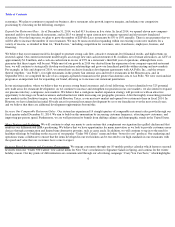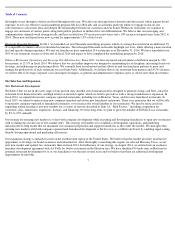El Pollo Loco 2015 Annual Report Download - page 20
Download and view the complete annual report
Please find page 20 of the 2015 El Pollo Loco annual report below. You can navigate through the pages in the report by either clicking on the pages listed below, or by using the keyword search tool below to find specific information within the annual report.
Table of Contents
unexpected losses resulting from natural disasters or other catastrophic events affecting our areas of operation, such as earthquakes, fires,
droughts, local strikes, terrorist attacks, increases in energy prices, explosions, or other natural or man-made disasters. The incidence and
severity of catastrophes are inherently unpredictable, and our losses from catastrophes could be substantial.
Our growth strategy depends in part on opening new restaurants in existing and new markets and expanding our franchise system. We may
be unsuccessful in opening new company-operated or franchised restaurants or in establishing new markets, which could adversely affect
our growth.
One of the key means to achieving our growth strategy will be through opening new restaurants and operating those restaurants on a profitable
basis. We opened eleven new company-operated restaurants in fiscal 2014 and plan to open an estimated sixteen in fiscal 2015. Our franchisees
opened five new restaurants in fiscal 2014 and plan to open eleven in fiscal 2015. The ability to open new restaurants is dependent upon a
number of factors, many of which are beyond our control, including our and our franchisees’ abilities to:
There is no guarantee that a sufficient number of suitable restaurant sites will be available in desirable areas or on terms that are acceptable to us
in order to achieve our growth plan. If we are unable to open new restaurants or sign new franchisees, or if restaurant openings are significantly
delayed, our earnings or revenue growth and our business could be materially and adversely affected, as we expect a portion of our growth to
come from new locations.
As part of our longer-term growth strategy, we may enter into geographic markets in which we have little or no prior operating or franchising
experience, through company-operated restaurant growth and franchise development agreements. The challenges of entering new markets
include (i) difficulties in hiring experienced personnel, (ii) unfamiliarity with local real estate markets and demographics, (iii) consumer
unfamiliarity with our brand, and (iv) competitive and economic conditions, consumer tastes, and discretionary spending patterns that are
different from and more difficult to predict or satisfy than in our existing markets. Consumer recognition of our brand has been important for our
success in our existing markets. In addition, restaurants that we open in new markets may take longer to reach expected sales and profit levels on
a consistent basis, and may have higher construction, occupancy, and operating costs, than restaurants that we open in existing markets, thereby
affecting our overall profitability. Any failure on our part to recognize or respond to these challenges may adversely affect the success of any
new restaurants. Expanding our franchise system could require the implementation, expense, and successful management of enhanced business
support systems, management information systems, and financial controls, as well as additional staffing, franchise support, and capital
expenditures and working capital.
16
•
identify available and suitable restaurant sites;
•
compete for restaurant sites;
•
reach acceptable agreements regarding the lease or purchase of locations;
•
obtain or have available the financing required to acquire and operate a restaurant, including construction and opening costs;
•
respond to unforeseen engineering or environmental problems with leased premises;
•
avoid the impact of inclement weather and natural and man
-
made disasters;
•
hire, train, and retain the skilled management and other employees necessary to meet staffing needs;
•
obtain, in a timely manner and for an acceptable cost, required licenses, permits, and regulatory approvals;
• respond effectively to any changes in local, state, and federal law and regulations that adversely affect our and our franchisees’ costs or
abilities to open new restaurants; and
•
control construction and equipment cost increases for new restaurants.
























